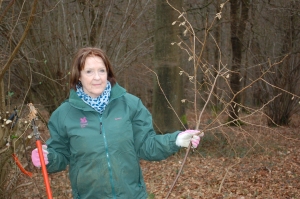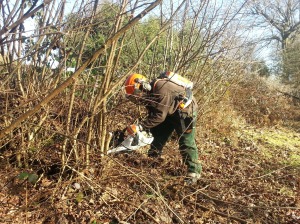Every February the garden team escapes from the lawns and borders of the formal garden and heads off into the woods and the wild garden to coppice hazel (Corylus avellana). Ditching secateurs and spades we take up pruning saws and loppers to cut hundreds of pea-sticks which we’ll use as plant supports in our garden borders; hazel branches are the ideal material .
So how do we coppice a pea-stick? Coppicing is a traditional term for cutting a tree or shrub down to ground level, or a low framework, in order to let the plant re-generate. The branches are naturally fan-shaped and with a little pruning to size are perfect for peas to grow through, hence the name, but can also be used as natural plant supports for tall annual and perennial plants in the border. Look-out for future blogs where you will see us placing the pea-sticks in the borders.
This year we have the benefit of a new battery-powered chainsaw. This is much less noisy than a petrol chainsaw and less disruptive to the tranquility of the woodland setting so much so that while we were there we enjoyed the cries of two buzzards circling overhead and the occasional rat-a-tat-tat-ing of a woodpecker.
The chainsaw doesn’t use forest fuels or emit any fumes and in future we’re hoping to re-charge it with solar panels as we already do with our battery-powered hedge-trimmers. . Nor is there any waste created because any material the Garden Team cannot use as pea-sticks will be taken up by the Woods Team to make all manner of products in their workshop. Woodland products are available to buy from the Plant Centre all year round and surplus pea-sticks are available from spring onwards.
Another benefit of coppicing is that it lets light into the forest floor providing an opportunity for our native flora to flourish. You can expect to see primroses (Primula vulgaris), celandine (Ficaria verna), wood spurge (Euphorbia amygdaloides) and our coveted English bluebell (Hyacinthoides non-scripta) re-colonise the ground as the hazel re-generates. It’ll be at least seven years before we return to this same spot in the woods to repeat the cycle.




